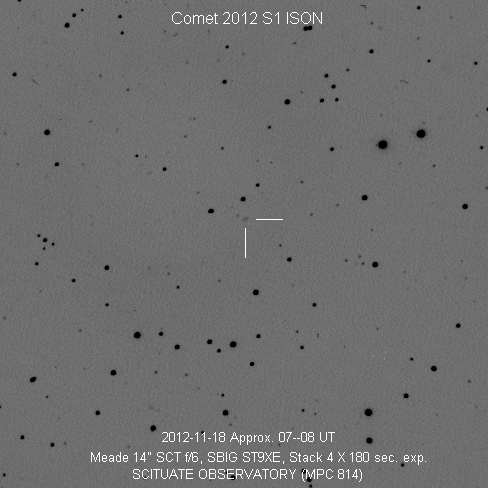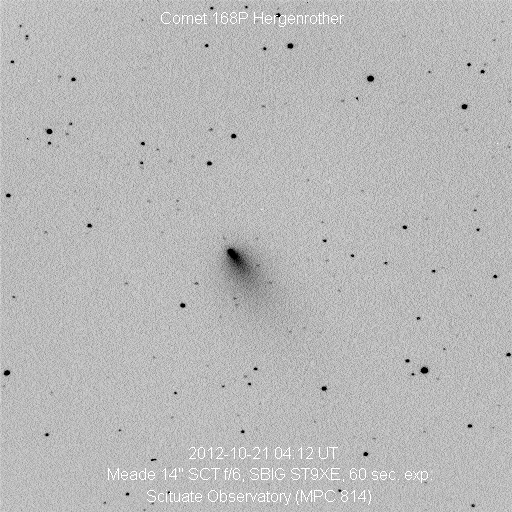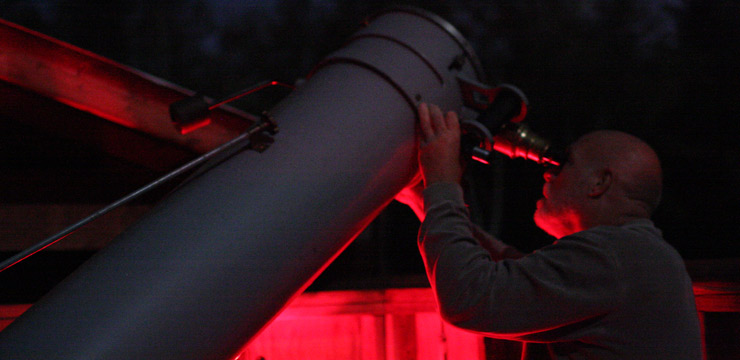November 2012 Comet Update
December 2012 :

COMET 2012 S1 ISON
This comet was discovered on Sept. 21, 2012 by two astronomers (from Belarus and Russia) at an observatory with a 16” Newtonian telescope near Kislovods, the North Caucasus region of Russia which is located between the Black and Caspian Seas. They also use Internet connected observatories here in the USA to do imaging remotely. A number of Russian area astronomers seem be quite active in comet and asteroid discoveries the last few years. This comet was named for the organization, ISON, which stand for “International Scientific Optical Network”. When the comet was discovered between the orbits of Saturn and Jupiter, it was thought to be an asteroid for a short period of time until its out gassing nature was detected and the discovery was changed to a comet. Very few new comets are found to be out gassing at such a distance from the sun and this may indicate that the nucleus is very large - possibly larger than 3 kilometers. It’s orbit is very close to parabolic and has a period of perhaps a few million years, which means it probably came from the Oort Cloud and extends from about 5,000 AU to more than a light year from the sun.
What is really interesting about Comet ISON is that in about one year from now, it will pass through perihelion (nearest point in its orbit to the sun) in late November, 2013. As such, it will pass extremely close to the surface of the sun - perhaps much less than 1 million miles - and will be a so-called Sungrazer. If it passes and survives such a close encounter with our sun, some very experienced and noted comet observers think it may approach magnitude -10 (minus 10) based on it’s current dust production and be visible during the daytime! Northern hemispheres observers could have a very spectacular view of this comet during the 2013-14 holidays season.
My first image was taken October 21, 2012 at Scituate Observatory, one month after discovery when the comet was about magnitude 17.5 and between the constellations Cancer and Gemini. The image shown here was taken on November 18, 2012, when the comet was still about magnitude 17.5 near the Cancer/Gemini border and beyond the orbit of Jupiter. These images show only a tiny star like dot and is detected by its motion relative to the background stars. Twelve months from now, it’s tail could be several degrees long across the sky...or, it could be a dud and get vaporized by the close solar surface passage! Stay tuned and keep watching this comet in the coming months as it gets within range of your telescopes and cameras!

COMET 168P HERGENROTHER
Comet 168P Hergenrother is another interesting comet in the evening sky the last several weeks, and currently about 12 degrees north of the Great Square of Pegasus. Normally, it would be about magnitude 15 or 16 and not a very interesting one to observe either visually or with a CCD. What makes this comet interesting is it suddenly brightened over 5 magnitudes just a few weeks ago and brought it into the range of visibility with larger binoculars at magnitude 9.5. When the image here was taken of Hergenrother on October 21, 2012 it was probably about magnitude 9.5 to 10. It does seen to oscillate in brightness and now seems to be between magnitude 10 and 11, which is still within visual range of at least 4 or 5 inch telescopes. My images do show an elongated nuclear region and slightly bent. Large observatories have detected apparent “fragments” (up to four at last count) of the nucleus that may account for it’s bright outburst and oscillations.
Continued observations of this comet could be very interesting if further outbursts occur and until it fades into the western sky.
Virtually all my observations are carried out via an Internet browser connection to my observatory. Once the observatory control server is started and the camera and telescope are initialized, all other imaging is remotely over the Internet connection. Friends and acquaintances from Skyscrapers, and other clubs, and as far away as Mexico, Hawaii and S. Korea have taken images with my online remotely accessible observatory.
Bob Napier, Scituate Observatory
Related Topics




